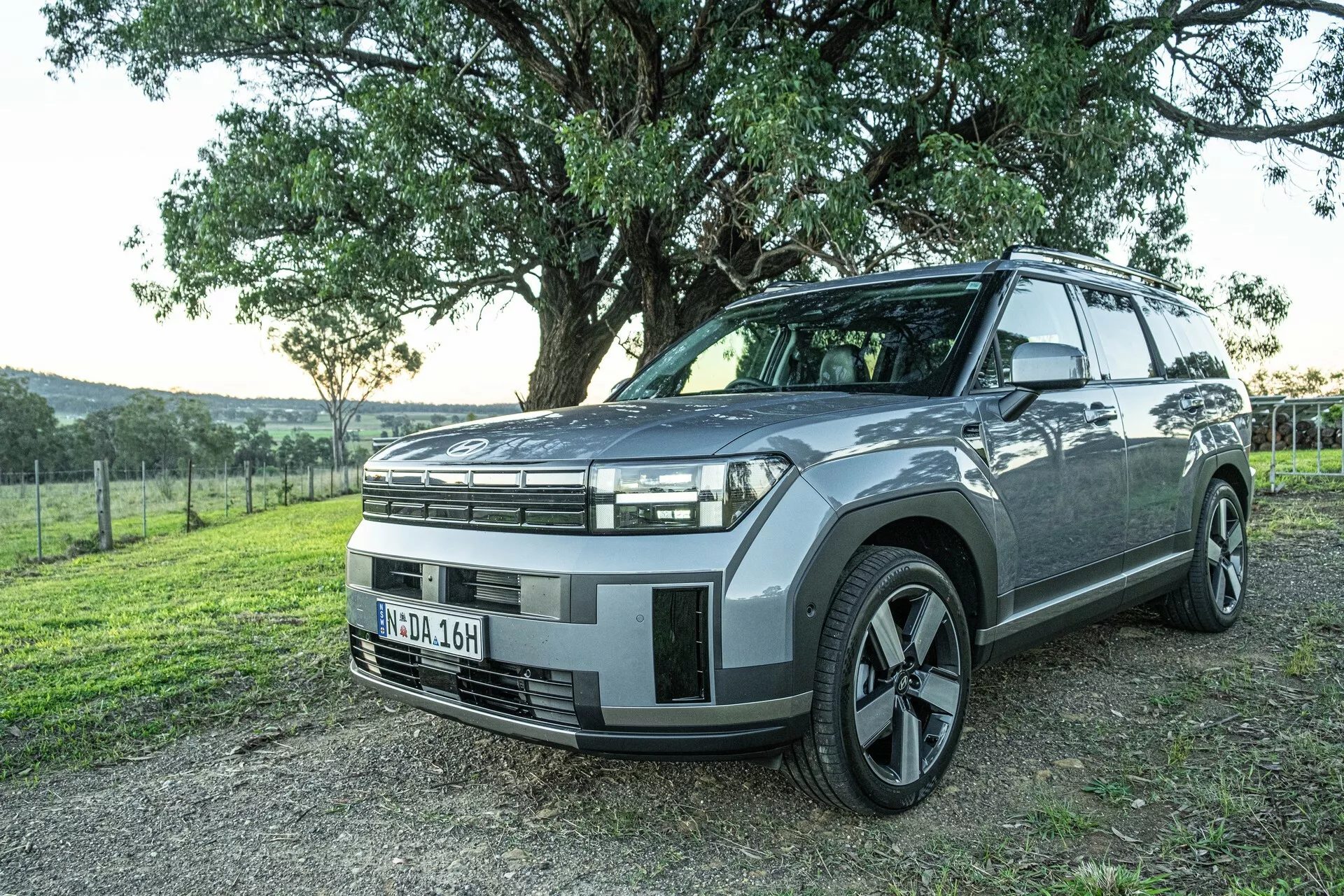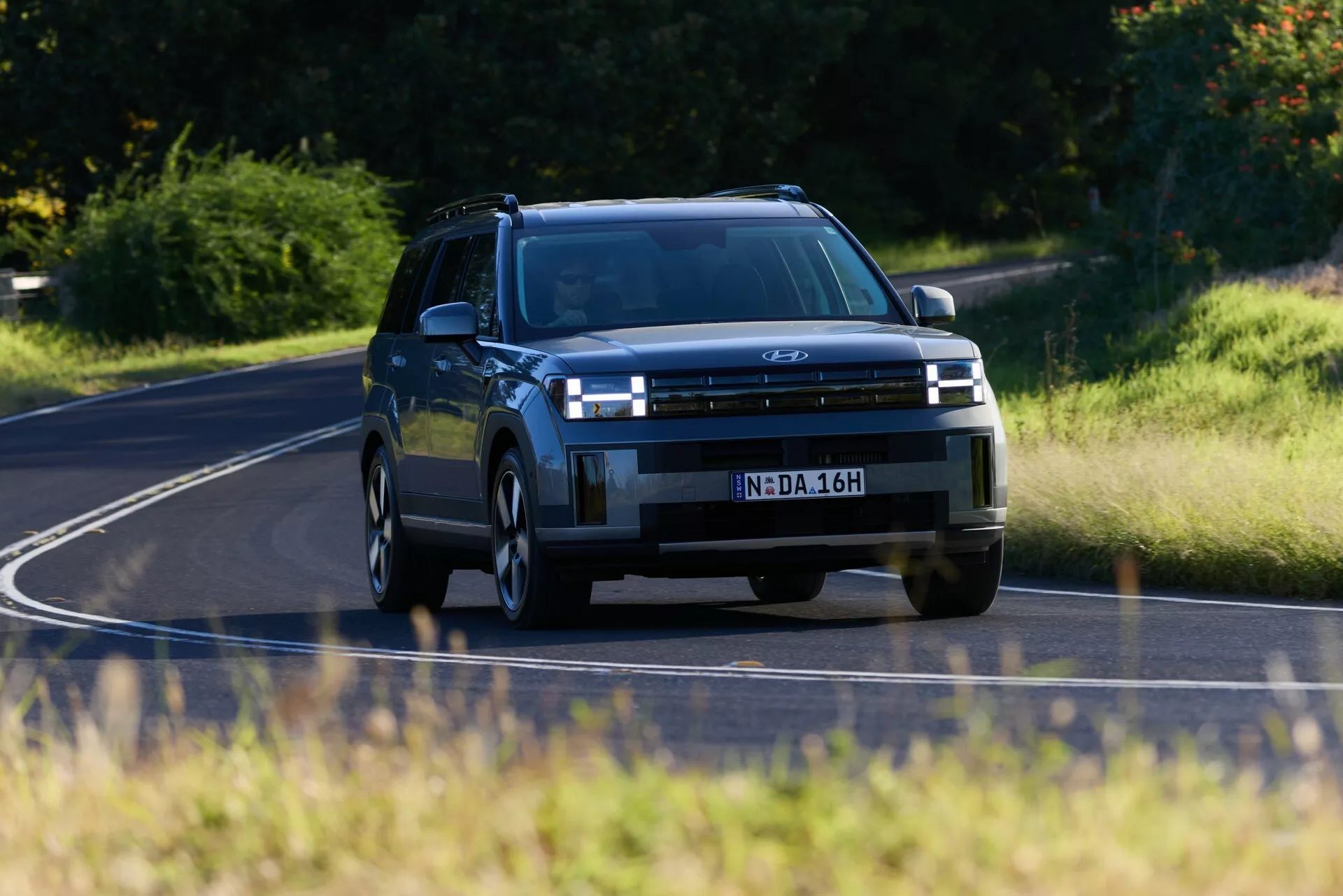With the release of the fifth version of the incredibly popular Hyundai Santa Fe, the company has broken all the rules, even though earlier generations of the car had some things in common. In contrast to its predecessors, it has a brand-new exterior, a remodeled interior, and a new 1.6-liter hybrid engine.
When Hyundai released the new Santa Fe in July of last year, it caused a lot of disagreement in the auto business because of how beautiful it looked on the outside. No matter what your opinion is, there is one fact about Santa Fe that we learned when we went to Australia to see it for the first time. This SUV is great. So, what makes it so great?
The 2025 Santa Fe comes to Australia in three trim levels and one hybrid version for the first time. A 1.49 kWh lithium-ion polymer battery pack, a 1.6-liter turbocharged gasoline engine, and an electric motor built into the transmission make up this drivetrain. At 1,000 to 4,100 rpm, the engine makes 367 Nm (271 lb-ft), and at 5,600 rpm, it makes 172 kW (231 horsepower). At 1,700 rpm, the electric engine makes 44.2 kW (59 hp) and 264 Nm (195 lb-ft).

At the start, this is the only engine that comes with the car, but Hyundai plans to add a 2.5-liter turbocharged gasoline engine in Q4. It has 206 kW (276 hp) of horsepower and 422 Nm (311 lb-ft) of torque. It also has an 8-speed dual-clutch automatic gearbox. The 2.2-liter CRDi diesel engine that was offered in the refreshed Kia Sorento and the Santa Fe that came before it has been taken off the market because of poor sales. Furthermore, Hyundai told us that most Santa Fe buyers will not need the extra towing power that a diesel car usually offers because hauling is not a big deal for them.
Hyundai thinks that 60% of Santa Fe sales in 2025 will be electric vehicles and 40% will be 2.5-liter cars.
The new Santa Fe is bigger than the old one. The car is 2.900 mm (74.8 inches) wide, 4.830 mm (190.1 inches) long, 1.720 mm (67.7 inches) tall, and has a wheelbase of 2,815 mm (110.8 inches). Because of this, it is 45 mm (1.7 inches) longer, 60 mm (2.3 inches) taller, and has a wheelbase that is 50 mm (1.9 inches) longer than the last one. It’s easier to tell the difference in size between the new Santa Fe and the old one in person because the new one is boxier and more straight.
In Australia, the new Santa Fe is available in ten matte colors, such as Creamy White matte and Earthy Brass matte.
The bottom line is the basic Santa Fe, which has both front- and all-wheel drive. The Elite shown above can only be bought with all-wheel drive. The line’s top model is the Calligraphy, which comes with six or seven seats. Hyundai Australia thinks that the base model and the Elite model will each make up 25% of sales, with Calligraphy being the choice of about 50% of buyers. The base model with front-wheel drive costs AU$ 55,500, which is about $36,900. The model with all-wheel drive costs AU$58,500, which is about $38,900. The Elite starts at AU$65,000 (~$43,300), and the Calligraphy goes up to AU$75,000 (~$49,900).
It’s a much better room
The inside of the new Santa Fe is different from the inside of the old one. We’ve always liked the inside of the fourth-generation model, but the new one feels much bigger and more expensive.
The 2017 Santa Fe’s steering wheel looks a lot different when you first get in. It was based on the Range Rover’s wheel. This wheel, which looks like the one on the Korean Hyundai Grandeur, correctly shows how big and heavy the new car is. A single Panoramic Curved Display is made up of two 12.3-inch screens in front of the wheel. It has Apple CarPlay and Android Auto preinstalled. You can get updates for your car’s performance, brakes, safety systems, and driving assistance features over the air, so you don’t have to go to a dealer.
During the SUV’s debut, we spent a lot of time in both the top-of-the-line Calligraphy and the base model. We were very happy with both. The base model costs only AU$55,500 (~$36,900) and comes with good features. It comes with a single wireless charging pad for smartphones and the panels from the top-of-the-line model, which have a display just for temperature control.
Shift-by-wire and moving the gear switch from the tunnel to the steering column are two big improvements to the fifth-generation Santa Fe. This made it possible for the company to put a large storage compartment under the tunnel instead of the shifter that was there before, which is more common in electric cars. In the base form, the seats are covered in a beautiful silky fabric.
Of course, the house at Santa Fe Calligraphy feels very different. It costs about AU$60,000 ($40,000) less than the Genesis GV80 we tried a few weeks ago, which is impressive. It feels almost as luxe.
Inside the Calligraphy, the dashboard, door panels, seats, and steering wheel are all made of beautiful, smooth leather that comes in many colors. There is a unique storage space at the top of the dashboard that uses UV-C light to clean things like phones, wallets, and glasses. There is also an ambient lighting system that can be used in different settings. The Elite and Calligraphy models can also charge two smartphones wirelessly at the same time. Along with that, the front seats and steering wheel are warm and cooled.
The Elite and Calligraphy models from Hyundai come with a great-sounding 12-speaker Bose music system. The Calligraphy also has a 22-way driving seat and an 8-way passenger seat, as well as a digital rearview mirror.
The availability of captain’s chairs increases the large amount of space in the second row. There is enough place for your head, feet, and legs. Oddly, there is a similar device for controlling the temperature in the second row. In order to control the temperature and air conditioning in the second row, the driver must instead use the screen in front of them. The tall ceiling makes the third row even more surprising by making it feel bigger than it is. There is a lot of room for individuals to sit there.
The redesigned Santa Fe has more space for goods. When the back seats are up, they can hold 628 liters (22.1 cubic feet) of stuff, and when they are folded down, they can hold 1,949 liters (68.8 cubic feet) of stuff.
Small operator
We drove the 2025 Santa Fe in its base form for most of the first day. The base model costs AU$55,500 (~$36,900), which is AU$7,500 (~$5,000) more than the base Santa Re from three years ago. Even though it costs a lot, the new Santa Fe feels much fancier and is fun to drive.
Before anything else, the inside is much better equipped than the last one, and there is almost no rough black plastic. It feels more like a huge jump than a step. The two screens are easy to use and show clear images. The leather is soft, and there is a lot of storage room. It’s also clear that the new Santa Fe has more room.
There was much debate about Hyundai’s choice to make the 2017 Santa Fe come standard with a hybrid engine, but we quickly came around to it. The system intelligently switches between pure electric power and hybrid mode when it thinks it’s time. The SUV blocks out a lot of noise. I could even ignore the sound of the 1.6-liter engine going without moving the car very much.
Although the Santa Fe HEV isn’t very fast, it easily and smoothly exceeds the speed limit. In addition, the motion is pretty smooth. Our mixed-cycle fuel consumption wasn’t quite as low as Hyundai said it would be (5.6 l/100 km or 42 US mpg), but we were easily able to get to 6 l/100 km (39.2 US mpg) on long trips.
Hyundai Australia is very proud of the fact that in the past few years, they have come up with their suspension tuning for the Australian circumstances. Hyundai says that its Korean engineers thought about how things work in Australia when they made the Santa Fe, so the SUV doesn’t need to be tuned for a better ride and handling. Representatives from Australia permitted two prototypes to be sent to Australia for testing without having to have the frame changed. It’s clear why. With this tool, you can feel good. Feels really good.
As we drove out of Sydney, Santa Fe felt at home on freeways winding through mountains and country roads. It doesn’t float, even though it’s well-damped, and it’s flexible enough to twist and turn. The front-wheel drive system in our base model was also more than enough for normal driving.
We weren’t able to try the slightly more expensive Elite, but we did get to drive the more expensive Calligraphy, which is expected to sell the most.
The interior of the Calligraphy is fancier than that of the Elite. It also has a dual sunroof, unique 20-inch metal wheels, and more safety features. Some of these are Remote Smart Park Assist, Smart Cruise Control based on navigation, and Highway Driving Assist 2, which can change lanes automatically. The C-pillar even has a useful grab handle built in to make getting to the roof rails easy.
The Nappa leather seats are pretty comfy. The only thing they don’t have is a massage function to make them feel truly luxurious. All-wheel drive sends power to both the front and back wheels without any problems. We couldn’t try out the different “Terrain” driving modes on the Calligraphy while it was on dirt. We’ll have to wait a week to make the change. It also didn’t let us test the pulling. Hyundai says it has the power to pull 3,637 pounds.
Final Thoughts
Looking at the pictures of the new Santa Fe that came out last year made me feel bad. But if you do it right, like in this matte white lettering, it can look pretty good.
Next is the house. There is a big difference between this model and the last one. It feels much nicer than the current Kia Sorento. There is more than enough technology, safety gear, good materials, and soft surfaces. Couple that with a very comfy ride, and you have a small SUV that is hard to miss. It has to be the most important thing on the shopping list for people in this price range.

COMMENTS